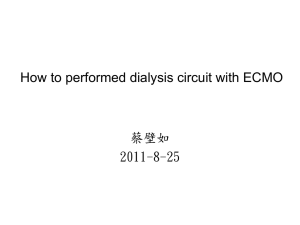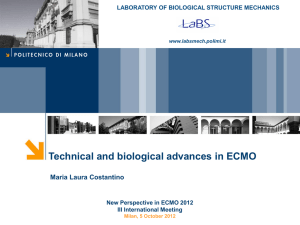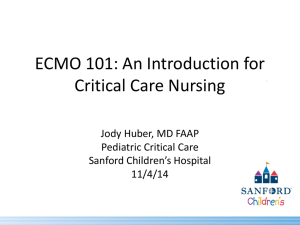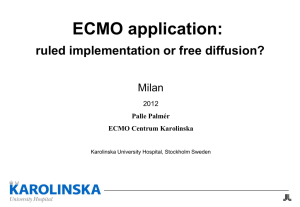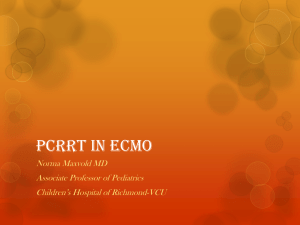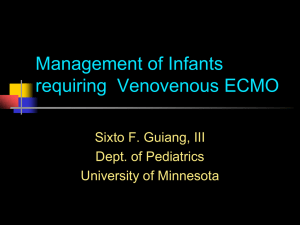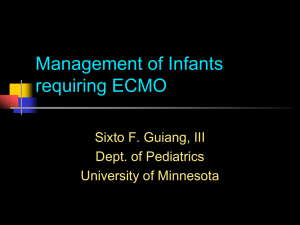ECHOCARDIOGRAPHIC MONITORING ON ECMO
advertisement
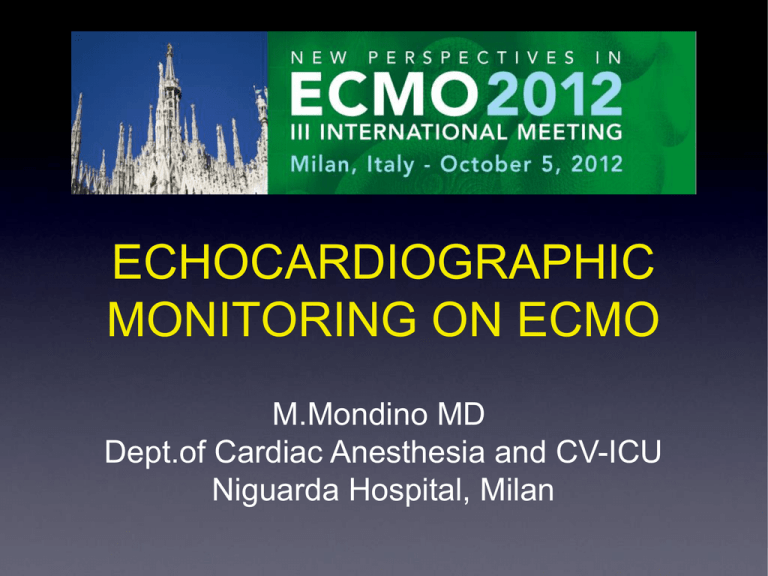
ECHOCARDIOGRAPHIC MONITORING ON ECMO M.Mondino MD Dept.of Cardiac Anesthesia and CV-ICU Niguarda Hospital, Milan Extra-Corporeal Membrane Oxygenation ECMO is a rescue therapy used to provide cardiac and/or respiratory support for critically ill patients in whom maximal conventional medical management has failed. V-V ECMO: provides adequate oxygenation and carbon dioxide removal in isolated refractory respiratory failure. V-A ECMO: when support is required for cardiac and/or respiratory failure. ECHOCARDIOGRAPHIC MONITORING ON ECMO • • • • • Patient selection Insertion and correct placement of cannulas Monitoring during support Detecting complications Decision making: cardiac recovery, weaning, bridge to.. ECHOCARDIOGRAPHIC MONITORING ON ECMO • Patient selection • • • • Insertion and correct placement of cannulas Monitoring during support Detecting complications Decision making: cardiac recovery, weaning, bridge to.. Pt selection - Reversible causes of hemodynamic instability V-A ECMO controindications Aortic dissection Aortic valve regurgitation Absoulte controindications Severe Arterial vascular disease central vs peripheral surgical vs percutaneous 4 Pt selection V-V ECMO controindications Severe Pulmonary Hypertension Cardiac Failure Consider VAECMO Pt selection Right Heart anomalies • atrial septal defect • interatrial septal aneurysm • patent foramen ovale • prominent Chiari network • pacemaker or ICD leads Pt selection Chiari’s network Chiari’s network: review of the literature, Marios Loukas et al., Surg Radiol Anat (2010) 32:895 901 Pt selection Interatrial septal aneurysm The Internet Journal of Cardiology ISSN: 1528-834,”Isolated large atrial septal aneurysm and multiple cerebral infarcts: Is there any association?” Gerasimos Gavrielatos et al. Pt selection Atrial septal defect (ASD) Patent foramen ovale (PFO) ECHOCARDIOGRAPHIC MONITORING ON ECMO • Patient selection • • • • Insertion and correct placement of cannulas Monitoring during support Detecting complications Decision making: cardiac recovery, weaning, bridge to.. Insertion and correct placement of cannulas Echocardography can visualize the correct position of both wires and cannula. Insertion and correct placement of cannulas 3d Echo Insertion and correct placement of cannulas Peripheral VA ECMO The venous cannula should be positioned in the mid right atrium to allow optimal blood flow into the circuit. The peripheral arterial cannula cannot be visualized. Imaging of the guide-wire in the ascending Ao can prevent malpositioning of the cannula. Insertion and correct placement of cannulas VA ECMO Insertion and correct placement of cannulas cVA-ECMO Insertion and correct placement of cannulas V-V ECMO The return cannula should be in the mid right atrium. The access cannula tip should be in the proximal IVC. Insertion and correct placement of cannulas V-V ECMO Echo is essential to check position of the cannulas in relation to IAS, PFO, LA, TV, CS etc. Incorrect cannula position can lead to: -Ricirculation -Inadequate blood flow -Myocardial injury Insertion and correct placement of cannulas Avalon cannula It consists of 2 lumens: -one lumen allows the deoxygenated blood to drain from the IVC and the SVC -the second lumen allows the oxygenated blood to return directed toward the tricuspid valve. -reduces the recirculation seen with the traditional V-V setup ECHOCARDIOGRAPHIC MONITORING ON ECMO • Patient selection • • • • Insertion and correct placement of cannulas Monitoring during support Detecting complications Decision making: cardiac recovery, weaning, bridge to.. Monitoring of the Pt on pVA-ECMO • • Underlying LV dysfunction Increased afterload due to retrograde VA Ecmo flow Insuffiencent unloading of LV • Pulmonary congestion, oedema, hemorrhage. • Blood stagnation in LV • Myocardial injury (affecting recovery) Monitoring of the Pt on pVA-ECMO Adequate LV unloading AHF in DCMP, pVA ECMO (3 days) + Inotropes + IABP. WP=13, RAP= 8 mmHg Echo Monitoring: Reg. - Myocardial contractility - LVEDV - Aortic Valve opening and Mitral Valve Monitoring of the Pt on VA-ECMO Adequate LV unloading 15 yrs. male. Acute myocarditis, pVA-Ecmo (day1) + IABP + Inotropes Monitoring of the Pt on VA-ECMO Adequate LV unloading is vital • Inotrops and vasodilators • IABP • Atrioseptostomie • LV vent • Anterograde and Retrograde LV unloading Monitoring of the Pt on VA-ECMO Adequate LV unloading Catena et al.,”Role of Echocardiography in the perioperative managment of mechanical circulatory support”. Best practice & Reserach Clinical Anaesthesiology 26 (2012) Monitoring of the Pt on VA-ECMO Adequate LV unloading Female, 2 ys; Fulminant myocarditis cVA ECMO (30 days) Bridged to recovery Monitoring of the Pt on VA-ECMO Adequate Venous Pressure unloading Female, 43 ys Liver congestion in acute cardiac decompensation of HCMP Monitoring of the Pt on VA-ECMO Adequate Venous Pressure unloading Hepatic vein flow Before pVA ECMO During pVA ECMO Monitoring of the Pt on V-V ECMO Increases mixed SvO2 Decreases PVR Decreases RV afterload Increases coronaries O2 content Increases LVEF ECHOCARDIOGRAPHIC MONITORING ON ECMO • Patient selection • • • • Insertion and correct placement of cannulas Monitoring during support Detecting complications Decision making: cardiac recovery, weaning, bridge to.. ECMO Complications Anticoagulation Bleeding Cannulas Thrombosis Displacement Flow Obstruction ECMO Complications - Thrombosis Intraventricular thrombosis is a well know complication of myocardial infraction. pECMO and LV akinesis can increase this risk. 31 ECMO Complications - Thrombosis “The Role of Echocardiography and Other Imaging Modalities in Patients With Left Ventricular Assist Devices”. Jerry D. J Am Coll Cardiol Img. 2010;3(10):1049-1064. ECMO Complications – Venous Flow obstruction Obstruction of the IVC: - Liver and splanchnic organs congestion Obstruction of the SVC: - SVC syndrome and reduced cerebral perfusion ECMO Complications - Flow obstruction Obstruction of the IVC Venous Flow obstruction ECMO Complications - Bleeding Tamponade Pericardial effusion might became evident when Ecmo support is reduced. ECMO Complications Cannula malposition • Interatrial septum • Coronary sinus • Across the tricuspid valve • Through a patent foramen ovale and into the LV ECMO Complications - Cannula malposition Atrial septal aneurysm occluding the inflow cannula. Augoustides J et al.. J Cardiothorac Vasc Anesth 17:113-120, 2003 ECHOCARDIOGRAPHIC MONITORING ON ECMO • Patient selection • • • • Insertion and correct placement of cannulas Monitoring during support Detecting complications Decision making: cardiac recovery, weaning, bridge to.. Weaning and Recovery IF and WHEN BTR, BTB, BTVAD, BTTx, BT? There are no established weaning guidelines clinical judgment hemo Echo dynamic variables parameter s Weaning and Recovery Echocardiographic parameters of possible recovery • LVEF > 35-40% • LVED diameter < 55mm • Aortic velocity-time integral >10 cm • Aortic Valve opening pattern • Absence of LV dilatation Weaning and Recovery Decreasing VA-ECMO support determines a reduction in LV afterload and increase in LV preload. Conventional echo recovery parameters are dependent on loading conditions. The systolic velocities (TDI-Sa) of the mitral annulus measured by Doppler tissue imaging were found to be load independent and to have significant prognostic value for predicting ECLS weaning. Aissaoui N.et al, JASE,Vol. 25, Issue 6, June 2012. michelegiovanni.mondino@ospedaleniguarda.it Thank You Niguarda Hospital 1950

